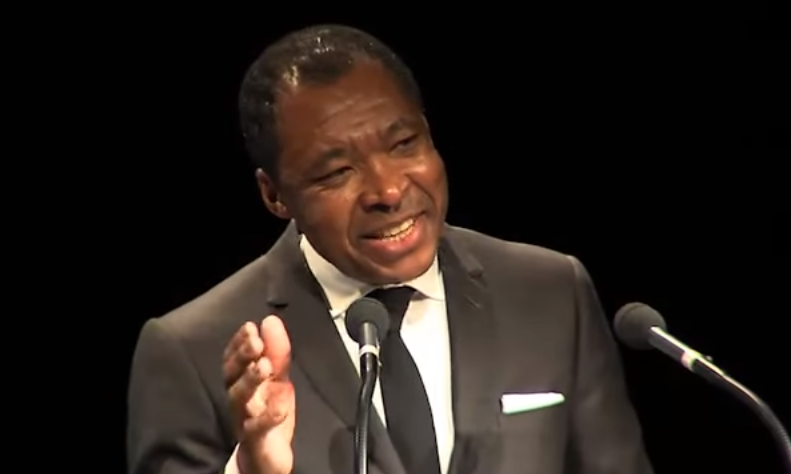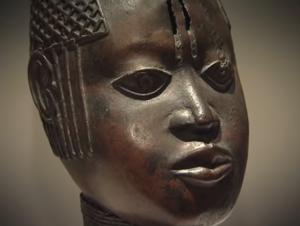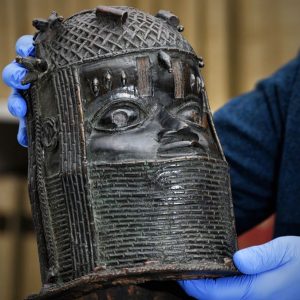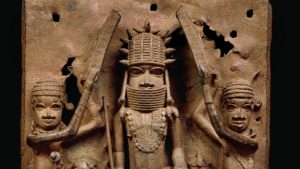
March 22, 2019, The Guardian, UK: ‘Okwui Enwezor: The Nigerian Who Confronted The European Art Canon’ By Oliver Basciano.
Okwui Enwezor, who has died aged 55, was a peerless, charismatic Nigerian curator who helped place non-western art histories on an equal footing with the long-established narrative of European and North American art. Part of a generation of auteur curators who rose to prominence in the 1990s, he, more than any other, was one with a mission.
“The way I see it, it is like night and day. The 80s and before was the colonial, Jim Crow, and apartheid days put together,” Enwezor said in 2005. “It was completely acceptable to the curators of the period that contemporary art did not happen in places like Africa, Asia, South America or the Middle East … globalisation transformed the myopia that previously ruled.”
The title of Enwezor’s main exhibition in the 2015 Venice Biennale, All the World’s Futures, was typically ambitious. With 139 artists to navigate, trying to see all of the exhibition was exhausting. Yet, due to the diversity of the artists on offer, the soreness of my feet was rewarded by the exhilaration of what I was seeing. Turn one corner and you might encounter work by the American land artist Robert Smithson; turn the next and you would find the Iraqi video maker Hiwa K. British film-maker John Akomfrah joined the Indian Raqs Media Collective; American painter Kerry James Marshall rubbed shoulders with the Kenyan video artist Wangechi Mutu.
Uncompromisingly, the centrepiece of the sprawling show was a continuous live reading of Marx’s Das Kapital. New discoveries abounded. I fell in love at first sight with Sammy Baloji’s copper domes engraved with scarification patterns of different Congolese communities. Watching Naeem Mohaimen’s Last Man in Dhaka Central, a feature-length film telling the story of a Dutch journalist imprisoned in Bangladesh in the 1970s, cemented my admiration for the British-Bangladeshi artist. Last year Mohaimen was included in the Turner prize, for which I was a jury member.
Enwezor was born in Calabar, the south-eastern Nigerian city, in 1963. An Igbo, he was caught up in the Biafran war of 1967–70 and his family moved around, eventually settling in Enugu, in the east of the country. Leaving for America aged 19, Enwezor studied political science at what is now New Jersey City University and became immersed in the New York poetry scene. Frustrated at the provincialism of the New York art scene, Enwezor started to write art criticism, founding Nka, a journal of art from Africa and its diaspora that still publishes today. In 1996, the Guggenheim asked Enwezor to curate an exhibition of African photographers which, the curator hoped, would “challenge longstanding western misconceptions about Africa.” It garnered rave reviews. Writing in the New York Times, Holland Cotter favourably compared Enwezor’s photography show to an “arrogantly underthought” concurrent survey of “African art” at the museum, which had travelled from the Royal Academy in London.
On seeing the biennale in Venice I kicked myself that, still a student in 2002, I had not been able to afford the airfare to Enwezor’s edition of Documenta, the quinquennial in Kassel. Regarded as seminal, it occupied five huge sites in the German city. Though earlier attempts had been made to tell a global history of art – notably Primitivism at MoMA in 1984, which paired western modernist sculpture and painting with “tribal art”, and the equally problematic Magiciens de la Terre at the Pompidou in 1989 – Enwezor pushed back at what he regarded as an ethnographic approach to non-western art. Instead, writing in the exhibition’s catalogue, he sought no less than “the full emergence of the margin at the centre”. It proved instrumental in the careers of many artists, not least Steve McQueen, Tania Bruguera and Shirin Neshat.
Enwezor refused to be defined by his two landmark exhibitions. For him just as important was his direction of the Johannesburg Biennale in 1996 and the Gwangju Biennale in South Korea in 2008, as well as Meeting Points 6, an exhibition which took place over 12 months from April 2011 in eight cities across Europe, the Middle East and north Africa, including Damascus, Tangier and Berlin. As adjunct curator of the International Center of Photography in New York, he organised Rise and Fall of Apartheid: Photography and the Bureaucracy of Everyday Life, a 2013 show praised as “pitched as much to the mind as to the heart” which featured over 600 documentary photographs, artworks, films, newsreel footage, books, magazines and archival documents. For most of the past decade however, Enwezor made his home in Munich – as director of the city’s Haus der Kunst where he concentrated on monographic solo exhibitions: Lynette Yiadom-Boakye, Hanne Darboven and Frank Bowling among the artists to be given run of the vast museum.
Enwezor’s approach to making shows was to do so “outside of the canon, but to it within culture”. His exhibitions were confrontational and never escapist. They could be hard going. Refusing to shy away from knotty politics or traumatic stories, the curator would often invoke the German philosopher Walter Benjamin and his description of a Paul Klee engraving in which an angel looks like it is moving away from the viewer while facing backwards. Enwezor, likewise, sought out artists whose interest in history might just offer a way forward.



